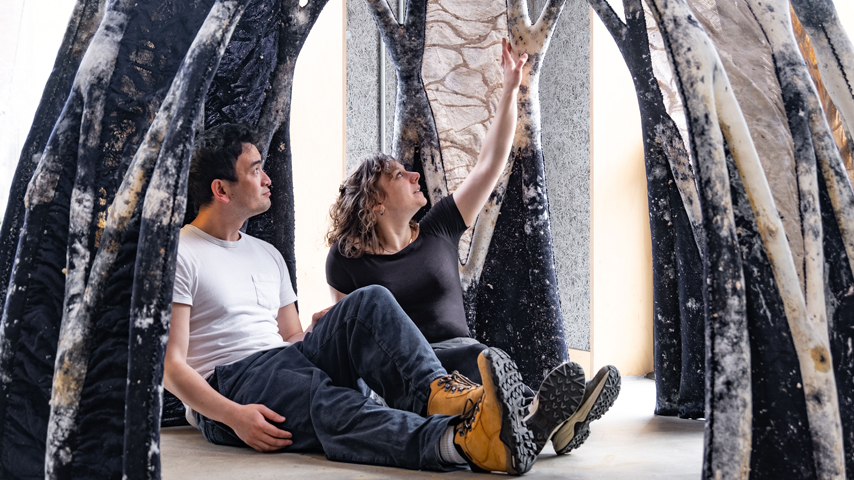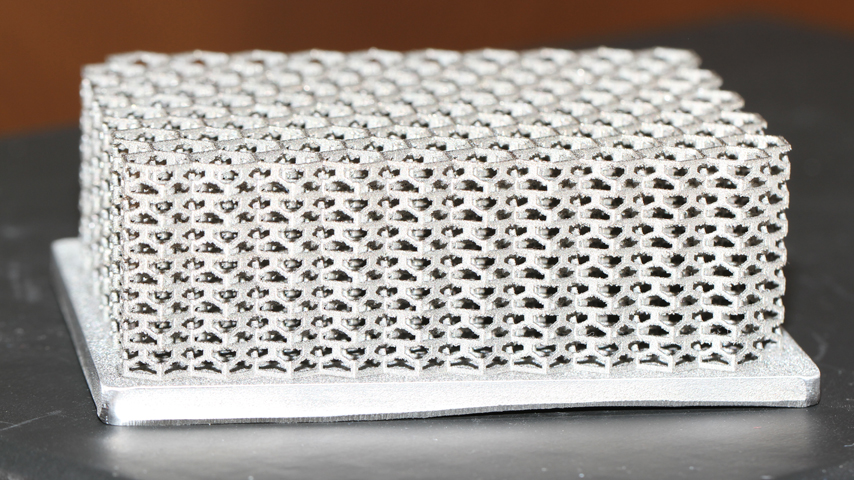Making Building Materials from Mycelium
Making Building Materials from Mycelium


Researchers at Newcastle University have developed a unique and eco-friendly composite building material from the root network of fungi.
As industries across the globe are working to become more sustainable and reduce their carbon footprints, the construction industry is having its own moment of reckoning. The environmental impact of modern construction materials cannot be denied and the manufacturing of those materials not only consumes significant fossil fuels but produces tons of carbon emissions.
To help reduce the impact, scientists have been working on new and more environmentally friendly material options. And now, researchers at Newcastle University in the United Kingdom have created a new composite called myocrete, a paste made from mycelium, or the root network for fungi, which could one day be used as a replacement for foam, timber, or plastic.
“There’s been a huge explosion in research looking at the potential of mycelium as a building material,” said Jane Scott, a Newcastle University Academic Track Fellow (NUAcT) at the school’s Hub for Biotechnology in the Built Environment. “It’s considered a bit of a wonder microorganism by a lot of different people and is being explored by different scientists for a wide variety of purposes. We saw that it really stood out as having a huge potential for construction, especially large-scale construction.”
Scott and colleagues created the myocrete paste by combining mycelium spores with materials they can feed on and then packing it into a mold with dark, humid, and warm conditions so the microorganisms can grow and bind together. It must then be dried out before the mushrooms start to fruit.
While other groups have attempted to leverage mycelium as a building material before, Scott said it has been a challenge to get these microorganisms to work at the scale of a built environment especially when you have to take the materials out of the lab and on to a building site. She said coming up with the right recipe took some trial and error.
“We understood that getting to the right viscosity was critical. We were working with this textile framework so we needed it to be soft and smooth enough to be injectable within a textile form but not so runny that it would seep out,” she said. “We spent a lot of time looking at the different ingredients and how to bring them together. Obviously, with mycelium, one of the key things is providing it with proper nutrition so it can grow.”
A second factor that helped with her team’s success, Scott said, was the use of knitted molds to create a “formwork” for construction. Mycelium not only requires the right nutrition and humidity to grow, it also needs oxygen. By using knitted molds, the team was able to make sure the mycelium was able to get ample oxygen.
“Knitting is incredibly versatile,” she said. “And it allows you to build structures with no seams or waste.”
After perfecting the recipe and the molds—and demonstrating that the myocrete showed good performance in tension, compression, and flexion—the team built a large proof-of-concept structure they named “The BioKnit.” This unique dome-shaped structure, which looks like a cozy spot to read or converse with friends, demonstrates the potential of using mycelium-textile hybrids in construction applications in the future.
When asked why her research group has been able to successfully leverage mycelium outside the lab, Scott credits bringing together a diverse and multi-disciplinary team to work on the project.
“We’re very lucky in our group to have such a wide breadth of experience,” she said. “We have expertise in mycelium, expertise in structural engineering, and expertise in textiles. It gave us the ability to explore the potential of mycelium and its potential to be knitted into a three-dimensional shape. It gives our work a slightly different flavor than those in other labs and also quite a bit of flexibility.”
Scott said her team has tested the myocrete for over a year and seen no degradation. She looks forward to doing more development work, as well as more long-term testing, to demonstrate myocrete’s feasibility as a construction material. She also hopes to find ways to leverage waste products to support future biofabrication projects.
“This work shows myocrete is a material that could be used in interior linings and interior surfaces within buildings,” she said. “We’re quite keen to challenge the preoccupation with box-shaped buildings and really think about how we might produce more organic forms and structures using this kind of technology."
Scott added, "Equally, I believe there are some conventional solutions that we might transition to as we work more with this technology, like alternatives for plasterboard or insulation materials. As we continue this work, we see the future of biofabrication as being very circular and offering us the opportunity to repurpose waste from one sector for biofabrication within construction. With more work, I believe we have the opportunity to completely transform the sustainability of construction materials.”
Kayt Sukel is a technology writer in Houston.
To help reduce the impact, scientists have been working on new and more environmentally friendly material options. And now, researchers at Newcastle University in the United Kingdom have created a new composite called myocrete, a paste made from mycelium, or the root network for fungi, which could one day be used as a replacement for foam, timber, or plastic.
“There’s been a huge explosion in research looking at the potential of mycelium as a building material,” said Jane Scott, a Newcastle University Academic Track Fellow (NUAcT) at the school’s Hub for Biotechnology in the Built Environment. “It’s considered a bit of a wonder microorganism by a lot of different people and is being explored by different scientists for a wide variety of purposes. We saw that it really stood out as having a huge potential for construction, especially large-scale construction.”
Become a Member: How to Join ASME
Scott and colleagues created the myocrete paste by combining mycelium spores with materials they can feed on and then packing it into a mold with dark, humid, and warm conditions so the microorganisms can grow and bind together. It must then be dried out before the mushrooms start to fruit.
While other groups have attempted to leverage mycelium as a building material before, Scott said it has been a challenge to get these microorganisms to work at the scale of a built environment especially when you have to take the materials out of the lab and on to a building site. She said coming up with the right recipe took some trial and error.
“We understood that getting to the right viscosity was critical. We were working with this textile framework so we needed it to be soft and smooth enough to be injectable within a textile form but not so runny that it would seep out,” she said. “We spent a lot of time looking at the different ingredients and how to bring them together. Obviously, with mycelium, one of the key things is providing it with proper nutrition so it can grow.”
A second factor that helped with her team’s success, Scott said, was the use of knitted molds to create a “formwork” for construction. Mycelium not only requires the right nutrition and humidity to grow, it also needs oxygen. By using knitted molds, the team was able to make sure the mycelium was able to get ample oxygen.
“Knitting is incredibly versatile,” she said. “And it allows you to build structures with no seams or waste.”
After perfecting the recipe and the molds—and demonstrating that the myocrete showed good performance in tension, compression, and flexion—the team built a large proof-of-concept structure they named “The BioKnit.” This unique dome-shaped structure, which looks like a cozy spot to read or converse with friends, demonstrates the potential of using mycelium-textile hybrids in construction applications in the future.
More for You: A Fungal Substrate for Sustainable Electronics
When asked why her research group has been able to successfully leverage mycelium outside the lab, Scott credits bringing together a diverse and multi-disciplinary team to work on the project.
“We’re very lucky in our group to have such a wide breadth of experience,” she said. “We have expertise in mycelium, expertise in structural engineering, and expertise in textiles. It gave us the ability to explore the potential of mycelium and its potential to be knitted into a three-dimensional shape. It gives our work a slightly different flavor than those in other labs and also quite a bit of flexibility.”
Scott said her team has tested the myocrete for over a year and seen no degradation. She looks forward to doing more development work, as well as more long-term testing, to demonstrate myocrete’s feasibility as a construction material. She also hopes to find ways to leverage waste products to support future biofabrication projects.
“This work shows myocrete is a material that could be used in interior linings and interior surfaces within buildings,” she said. “We’re quite keen to challenge the preoccupation with box-shaped buildings and really think about how we might produce more organic forms and structures using this kind of technology."
Scott added, "Equally, I believe there are some conventional solutions that we might transition to as we work more with this technology, like alternatives for plasterboard or insulation materials. As we continue this work, we see the future of biofabrication as being very circular and offering us the opportunity to repurpose waste from one sector for biofabrication within construction. With more work, I believe we have the opportunity to completely transform the sustainability of construction materials.”
Kayt Sukel is a technology writer in Houston.



